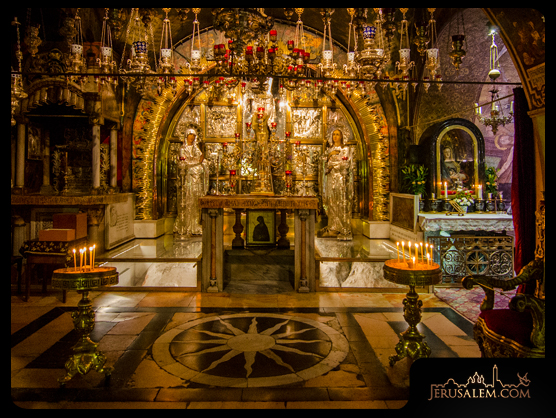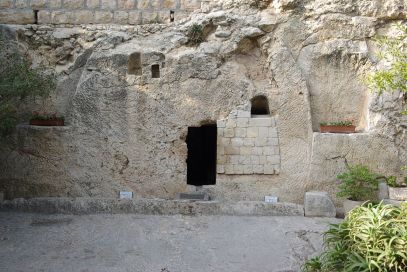In February, I joined over one hundred United Methodists from Georgia who visited the Holy Land. I am sharing my reflections about the pilgrimage in a series of journal entries.
We spent the final day of our Holy Land Tour in Jerusalem. The bus dropped us atop the Mount of Olives with a panoramic view of the city. After a group photo with the Dome of the Rock in the background, we followed the traditional route of Jesus’ triumphal entry on Palm Sunday.
Tombs line the slopes where the Jewish faithful have been buried for 3,000 years. According to a religious legend based on Zechariah 14:4, the resurrection of the dead will begin on the Mount of Olives when the Messiah comes.
The site of the Garden of Gethsemane rests at the foot of the hillside. We walked through a grove of ancient olive trees before entering the cathedral. The Church of All Nations rests on the foundations of two earlier churches from the 4th and 12th centuries. The Roman Catholic church covers a rock where Jesus’ prayed “Thy will be done” the night before his death.
Entering the Old City of Jerusalem, we visited the Pool of Bethesda where Jesus healed an invalid on the Sabbath. Then we walked the Via Dolorosa and paused at plagues designating the Stations of the Cross.
The Church of the Holy Sepulcher (or Sepulchre) marks the traditional location of Jesus’ crucifixion and resurrection. Although the claim cannot be supported with historical certainly, Christians have worshiped at this sacred site since the fourth century.
Past the entrance we climbed a stairway on the left that ascended to the site of Golgotha. Under an elaborate altar, pilgrims knelt and touched the rock where the crucifixion took place. The Chapel of Adam is located beneath the altar. Legend claims the blood of Jesus seeped through the rock and covered the skeletal remains of First Man.
A large rotunda left of the entrance houses the traditional site of Jesus’ tomb. I stood in a line winding around the sepulcher. The anteroom contained the “Angel’s Stone” which is purportedly a piece of the stone that sealed Christ’s tomb. A priest stood inside, directing three people at a time to enter the second chamber of the tomb itself.
The low entrance forced us to bow while entering the site of Jesus’ burial. An altar marked the place where Joseph of Arimathea placed the body. We knelt in silent reverence on holy ground.
Later in the afternoon we visited a second site claiming to be the possible place of the cross and empty tomb. Golgotha (Calvary in Latin) literally means “the place of the skull.” A British general and amateur archaeologist named Gordon found a rock formation outside Jerusalem’s walls that resembled a skull. He then unearthed a tomb nearby bearing a striking resemblance to the Gospel’s descriptions of Jesus’ burial place.
The Garden Tomb certainly gave us a sense of what the tomb might have looked like. Our British host talked about the various claims supporting the Church of the Holy Sepulcher and Gordon’s Calvary. Finally, he paused and said in true English fashion: “However, ultimately it doesn’t matter which site is authentic. The important thing to remember, you see, is THE TOMB IS EMPTY!”
The Crucifixion and the Resurrection bisect history. History swings on the hinges of the cross and empty tomb. On the far side of Easter, nothing remains the same.
The Easter angel’s words continue to ring down through the centuries and in our ears: “Why do you seek the living among the dead? He is not here—he is risen!”
God has conquered sin and death. Jesus Christ is the firstborn of the resurrection, and he invites us to receive life, abundant life, and everlasting life. Easter people need not fear the grave because we serve the Lord of Life.
The important thing to remember, you see, is THE TOMB IS EMPTY!



I have enjoyed your posts from your trip to the Holy Land……..thanks for sharing the experience with us!
LikeLike
Thank you for sharing your Holy Land journal with us. I would so love to experience this myself, one day. Participating in “The Way of the Cross” really shook my understanding of the views of the followers and enemies of Jesus. Actually seeing the sites where these things took place (even if some were only replicas or depictions) must be transcending. Your words and photos have helped me to see the land and culture that still cries out, “He is risen!”
LikeLike
Fabulous, B2 … now I see why you said it was ‘life changing.’ Thanks.
LikeLike
Thank you for sharing this journey and for leading us there. What an extraordinary difference it has made in my life and in the way I read the Word. You have captured the true feel of the pilgrimage for us all.
LikeLike
Thanks so much for your deligence in preparing these blogs. It brings back so many rich memories. The Garden tomb remains the same. You certainly gave this trip your all. Thanks again.
LikeLike